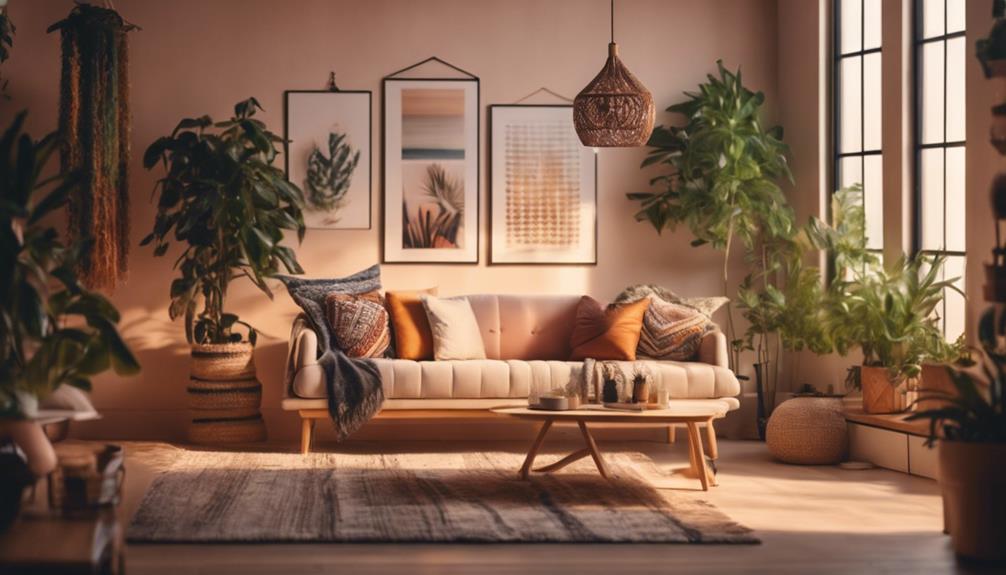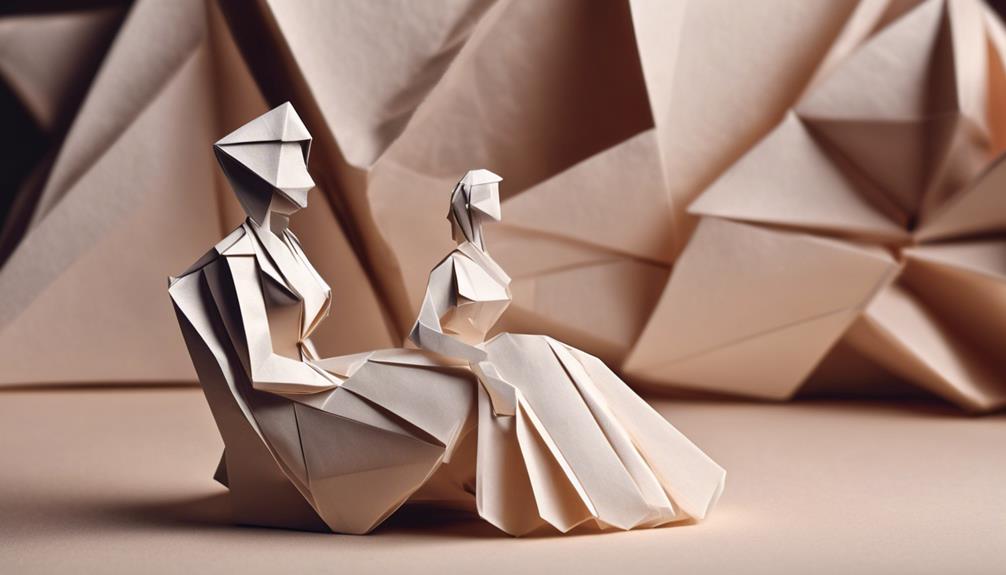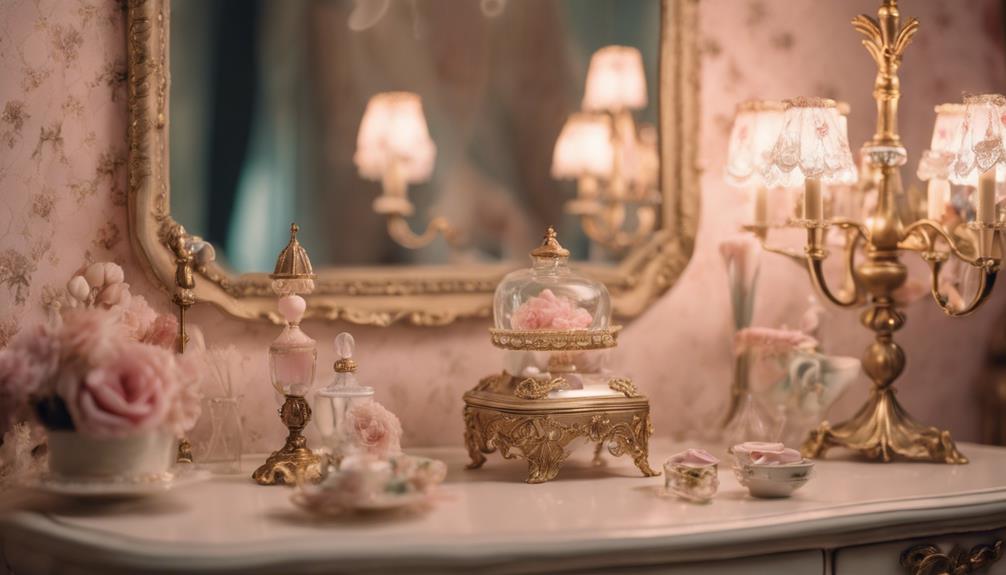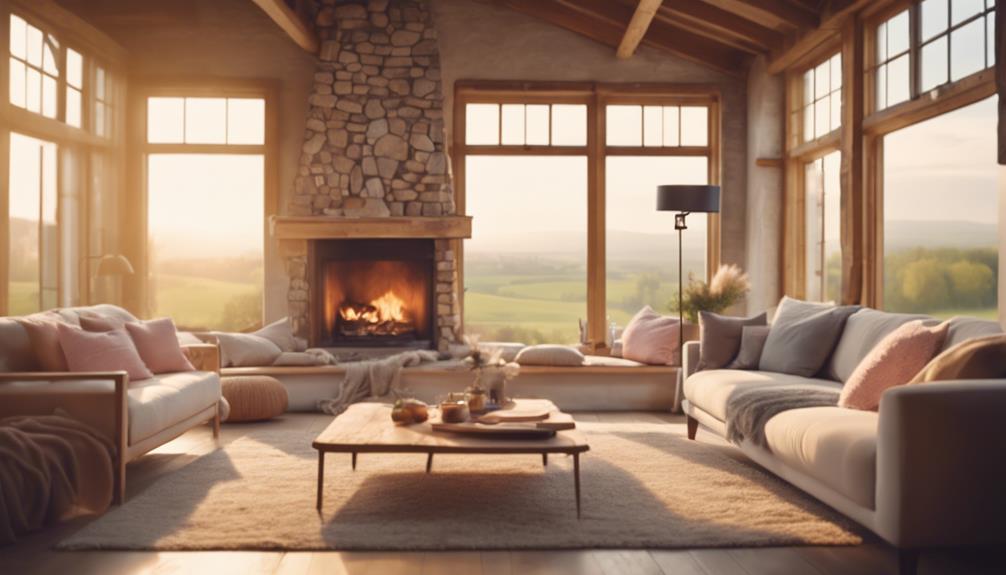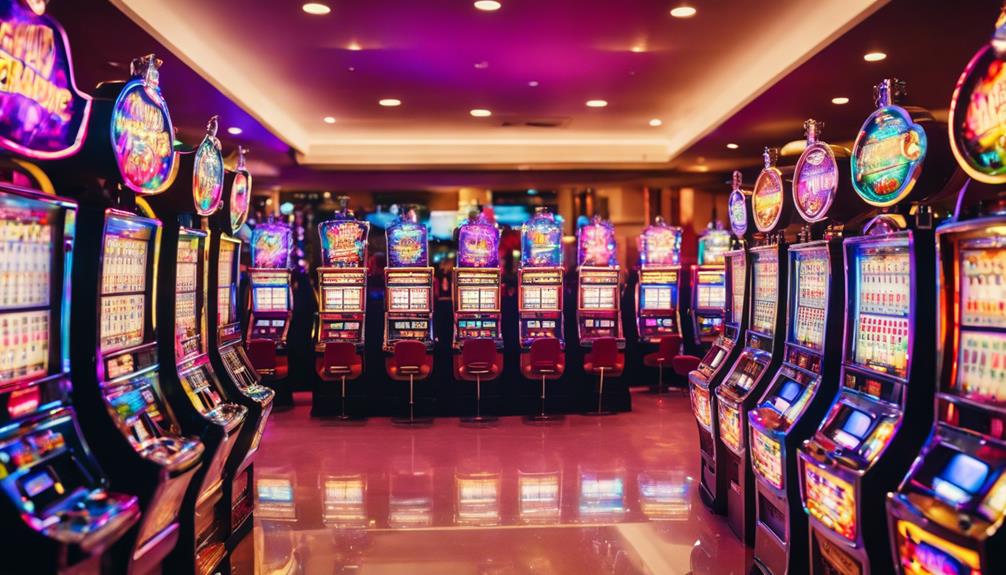To stay ahead with the latest aesthetic trends in room decor, you'll want to embrace vibrant color schemes and eco-friendly materials. Think bubblegum pink accent walls paired with reclaimed wood furniture for a unique touch. Layering different textures, like velvet and wood, adds depth and warmth to your space. Don't forget to incorporate statement lighting, such as vintage-inspired table lamps and chic floor lamps, for a stylish ambiance. Enhance your decor with artisanal pieces, like handcrafted vases or botanical art prints, which reflect your personality. Discover how to elevate your decor even further with more trendy ideas to rejuvenate your space!
Key Elements

When it comes to trendy room decor, the right color scheme sets the tone for your space.
You'll want to choose materials and textures that not only look good but also enhance the overall vibe.
Mixing vibrant colors with varied textiles can create a dynamic and inviting atmosphere.
Color Scheme
A vibrant color scheme can transform your space, infusing it with energy and personality while breaking away from dull, monochromatic designs. Consider incorporating bold hues like bubblegum pink and turquoise, which are gaining popularity for their ability to inject joy and liveliness into any room. Pair soft pinks with pops of green and orange textiles to create a warm, inviting atmosphere that enhances your overall aesthetic.
Accent walls in striking colors or unique patterns can act as stunning backdrops for decorative elements like shelves and plants. They not only warm up your space but also serve as focal points that draw the eye. If you want to add depth, try a two-tone color scheme; this trend creates serene yet enchanting ambiances that keep your decor fresh and exciting.
Don't forget about earth tones! They provide a grounding effect and can beautifully complement brighter shades, creating balance in your color scheme. By layering different textures through fabrics and materials—think dyed pillows and knit blankets—you can enhance visual interest and richness in your decor.
Embrace these trends to truly elevate your space!
Materials
Incorporating the right materials not only enhances your room's aesthetic but also supports a sustainable lifestyle that resonates with modern decor trends. Choose eco-friendly materials like bamboo, reclaimed wood, and organic fabrics to create a harmonious environment. These choices align with the growing emphasis on sustainability, making your space both stylish and responsible.
Natural elements, such as plants and organic textiles, not only elevate your decor but also promote your well-being. They introduce earthy colors and textures that connect your home to nature. Layering different materials, like soft textiles with rustic woods, creates visual interest and depth, giving your room a cozy atmosphere.
Don't overlook unique and artisanal decor pieces, like handmade ceramics or vintage finds. These materials emphasize authenticity and add a personal touch to your space.
Additionally, integrating smart technology, such as voice-activated lighting, enhances functionality and style, allowing you to enjoy a modern aesthetic without compromising on eco-friendliness.
Textures
Textures play an essential role in transforming your space, inviting you to engage with the room on a sensory level. By layering different textures, like knit blankets, macrame plant holders, and dyed pillows, you enhance visual interest and create a rich sensory experience. Mixing materials—soft velvet, rough wood, and smooth metals—contributes to a dynamic and inviting atmosphere that draws you in.
Incorporating plush items in cozy spaces evokes feelings of comfort and warmth, encouraging relaxation and an inviting ambiance. You can also experiment with matte and glossy finishes in your decor elements, which creates depth and contrast, adding sophistication to your interior design.
To achieve a balanced look, consider combining woven rugs with sleek furniture. This textural variety helps to harmonize your room's design while promoting a smooth flow throughout the space. Ultimately, the right textures not only elevate the aesthetic but also set the mood and enhance the overall experience of your home.
Essential Fixtures and Furniture
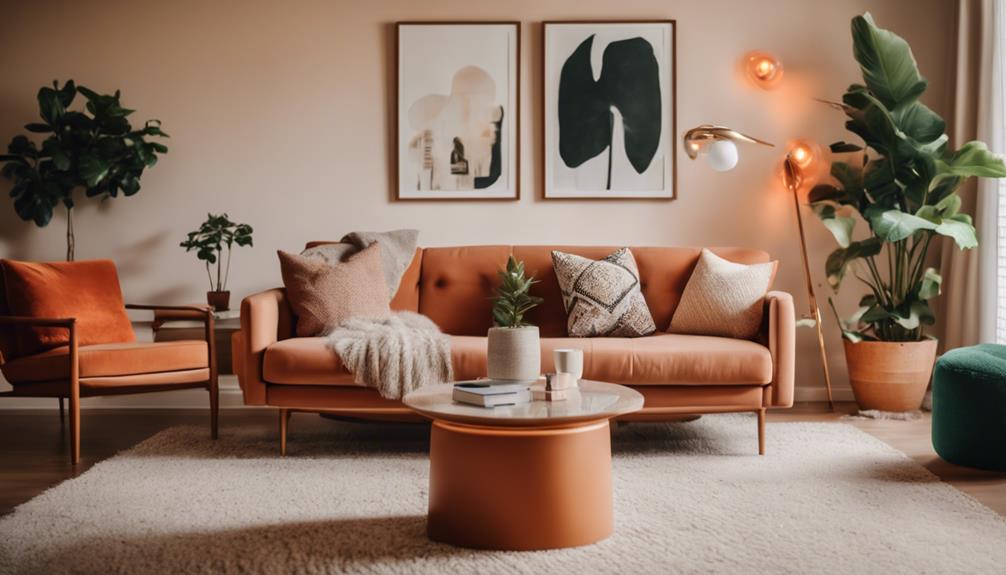
When it comes to essential fixtures and furniture, you'll want to focus on pieces that blend style with function.
A vintage mid-century coffee table can serve as a striking centerpiece, while a sleek Scandinavian side table adds modern elegance.
Don't overlook an artisan-crafted wooden bookshelf, which not only showcases your favorite reads but also elevates your room's aesthetic.
Vintage Mid-Century Coffee Table
A vintage mid-century coffee table can effortlessly elevate your living space with its sleek design and timeless appeal. Characterized by clean lines and organic shapes, this piece adds sophistication to your home decor while fitting seamlessly into various styles. Typically crafted from materials like teak or walnut, these tables often feature tapered legs and minimalist aesthetics that are both practical and beautiful.
One of the best things about a vintage mid-century coffee table is its functionality. Many designs include hidden storage or dual surfaces, making them perfect for both style and utility. As home decor trends lean towards sustainability, investing in a vintage piece not only enhances your space but also showcases a commitment to reusing quality craftsmanship from the past.
With the resurgence of mid-century modern design, you'll find an increased availability of authentic vintage tables and high-quality reproductions. This accessibility means you can easily find the perfect vintage mid-century coffee table that complements your living room, making it a stylish focal point that reflects your taste while staying ahead of the latest trends.
Sleek Scandinavian Side Table
Sleek Scandinavian side tables seamlessly blend minimalist design with functionality, making them essential fixtures for modern living spaces. Their clean lines and neutral color palettes create a sophisticated backdrop that complements any decor. Crafted from light woods like birch or oak, these tables not only enhance your home's aesthetic but also promote a warm and inviting atmosphere.
One of the standout features of sleek Scandinavian side tables is their versatility. Many come with built-in storage or adjustable heights, allowing you to customize your setup to fit your needs. This adaptability is perfect for those who appreciate a modern look that doesn't compromise on practicality.
Emphasizing the principles of hygge, these side tables encourage coziness and comfort, making them ideal for your living room or bedroom. Brands like IKEA and Muuto offer a variety of options that cater to different tastes and budgets, ensuring you'll find the right piece for your space.
Investing in a sleek Scandinavian side table means embracing a blend of style and function, enhancing your home while staying ahead of the latest aesthetic trends.
Artisan-crafted Wooden Bookshelf
Artisan-crafted wooden bookshelves not only provide essential storage but also transform your space into a warm and inviting showcase of personal style. These unique pieces serve as stunning focal points that add character to any room's decor. Each bookshelf features distinct grain patterns and finishes, making it a one-of-a-kind addition to your home.
When you invest in an artisan bookshelf, you're also supporting sustainable practices. Many craftsmen use reclaimed wood or eco-friendly materials, aligning with current decorating trends that prioritize environmental consciousness. Customizable options make it easy to find the perfect fit for your space and aesthetic preferences, whether you prefer a minimalist look or something more ornate.
Incorporating an artisan bookshelf into your decor enhances visual interest. You can display your favorite books, plants, and decorative objects, showcasing your personal style in an organized manner. This not only maximizes storage but also creates a curated look that reflects who you are.
Lighting Ideas
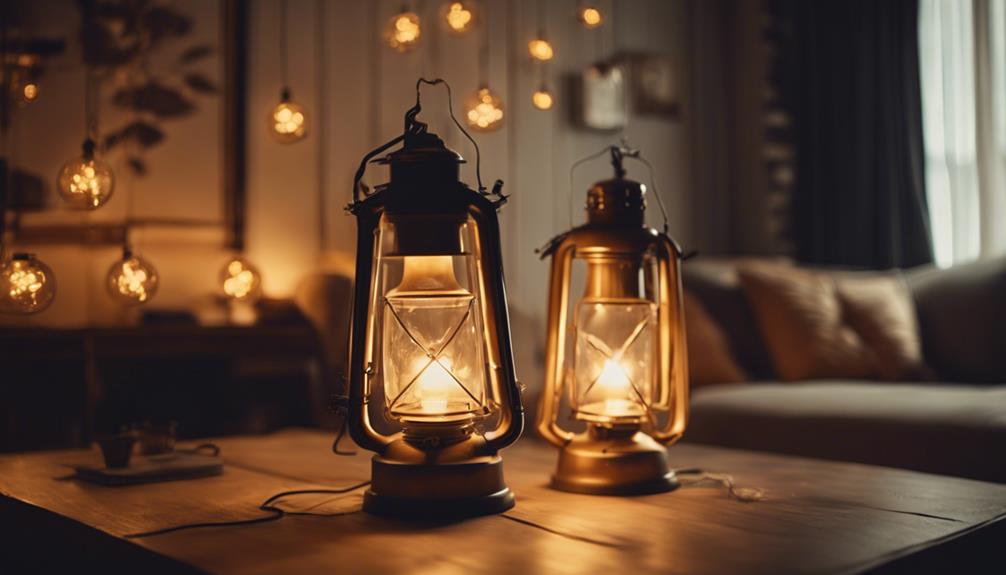
When it comes to lighting, you can transform your space with a statement pendant light fixture or warm LED strip lighting for a cozy vibe.
Chic floor lamps with shades and vintage-inspired table lamps add character and style to any room.
Let's explore how these options can enhance your decor and create the perfect ambiance.
Statement Pendant Light Fixture
A statement pendant light fixture can instantly transform your space, serving as both a striking focal point and a source of targeted illumination.
These fixtures not only enhance the aesthetics of your room but also play an essential role in its functionality. With a wide array of design styles available—ranging from modern and minimalist to vintage and artistic—you can easily find a pendant that complements your decor.
When choosing a statement pendant light, consider the materials used. Options like metal, glass, and wood can contribute to your overall theme while ensuring durability. Many of these fixtures also come with adjustable heights and dimmable settings, giving you the flexibility to create the perfect ambiance for any occasion.
Incorporating a statement pendant light into your home or workspace is a trendy choice that elevates the design while providing effective lighting.
Warm LED Strip Lighting
Warm LED strip lighting effortlessly enhances your space, creating a cozy atmosphere that invites relaxation and comfort.
These energy-efficient lights consume up to 80% less energy than traditional incandescent bulbs, making them a smart choice for anyone looking to improve their home decor sustainably. With adjustable color temperatures, you can customize the lighting to suit your mood—whether you want a warm glow for a laid-back evening or vibrant hues for a lively gathering.
Installation is a breeze, allowing you to accentuate architectural features, highlight artwork, or provide backlighting for furniture, adding depth and interest to your room's ambiance. You can easily transform an ordinary space into a stylish haven with just a few strips of LED lights.
For added convenience, consider smart LED strip lights that integrate with your home automation system. You can control brightness and color through voice commands or mobile apps, making it simple to personalize your lighting experience.
Embrace the trend of warm LED strip lighting to boost your room's ambiance and create a welcoming environment that reflects your unique style.
Chic Floor Lamps With Shades
Chic floor lamps with shades elevate your lighting game while adding a touch of style to any room. These lamps provide not just ambient lighting but also serve as eye-catching decor pieces that enhance your space's overall aesthetics. By choosing materials like fabric, metal, or glass, you can find designs that range from minimalist to bohemian, making it easy to find the perfect fit for your decor.
Adjustable floor lamps with dimming features let you customize your lighting, adapting to various moods and activities, whether you're reading a book or hosting friends. Incorporating natural elements, like rattan or woven textures, aligns with the current trend of biophilic decor, creating a warm and inviting atmosphere that can truly make your room feel cozy.
If you're looking to make a statement, vintage-inspired floor lamps with unique shapes can reflect your personal style and add character to your space. In a world where lighting can completely transform a room, chic floor lamps with shades are an essential element to evaluate.
Vintage-inspired Table Lamp
Vintage-inspired table lamps bring character and charm to your space, turning functional lighting into an enchanting decor element. With ornate designs like stained glass or intricate metalwork, these lamps serve as stunning statement pieces that elevate any room.
You'll find a variety of styles, including Art Deco, Mid-Century Modern, and Industrial, allowing you to seamlessly integrate them into your aesthetic theme. Incorporating a vintage-inspired table lamp not only enhances ambient lighting but also creates a cozy atmosphere.
It highlights the unique character of your space, drawing the eye and sparking conversation. Many of these lamps utilize energy-efficient LED bulbs, offering a sustainable lighting option that doesn't compromise on style.
As vintage decor trends resurge, the demand for these table lamps has skyrocketed, making them a sought-after choice for anyone looking to create a nostalgic and inviting environment.
When you choose a vintage-inspired table lamp, you're not just adding light; you're infusing your home with personality and warmth. So, go ahead and let these beautiful lamps illuminate your space while telling a story of their own!
Decorative Elements
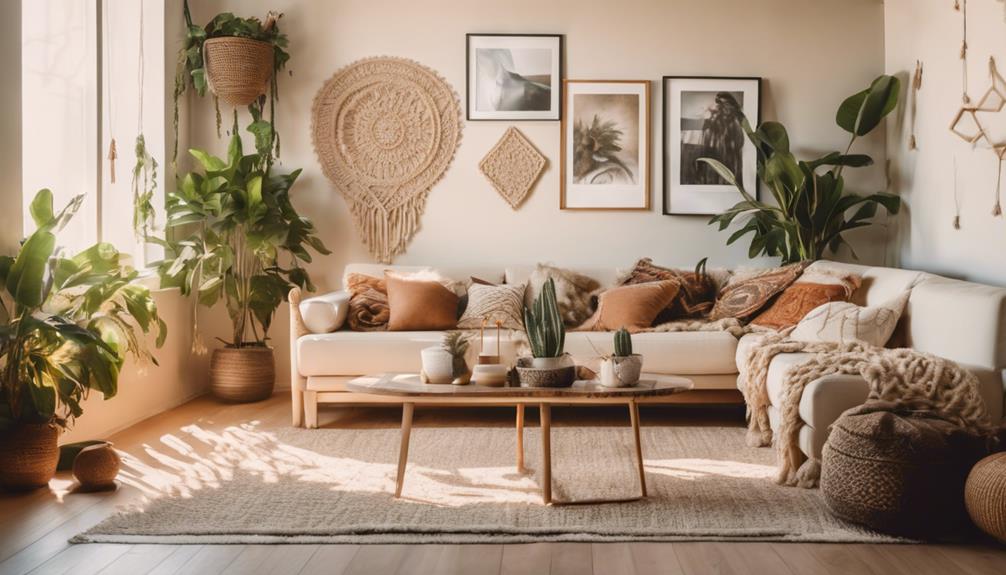
To elevate your space, consider incorporating an artisan ceramic vase as a striking centerpiece.
Framed botanical art prints can bring a touch of nature indoors, while handwoven macramé wall hangings add texture and warmth.
These decorative elements not only enhance your decor but also reflect your personal style.
Artisan Ceramic Vase Centerpiece
An artisan ceramic vase centerpiece transforms any space into a vibrant showcase of creativity and craftsmanship, inviting a unique touch to your home decor. These artisan ceramic vases are versatile decorative elements that enhance any room's aesthetic. With various shapes, sizes, and glazes available, they allow you to personalize your space, whether you lean toward a minimalist or maximalist style.
Incorporating these handcrafted ceramics not only supports local artisans but also aligns with sustainable practices, making your home eco-friendly. When you fill these vases with fresh or dried flowers, you elevate their visual appeal while adding a natural element that complements current biophilic design trends.
Positioning an artisan ceramic vase as a focal point draws attention and creates a cohesive look. Pair it with complementary decor elements like fabrics and wall art to enhance the overall design. By choosing the right artisan ceramic vases, you can make your home reflect your personality and style, turning ordinary spaces into extraordinary expressions of art.
Framed Botanical Art Print
Framed botanical art prints breathe life into your space, effortlessly bringing the beauty of nature indoors. These prints not only add a touch of greenery but also resonate with current trends like biophilic design, which emphasizes a connection to the environment. You can choose from various plant species, ranging from lush tropical leaves to delicate florals, enhancing your room's aesthetic appeal.
Incorporating framed botanical art prints can elevate your space's ambiance, creating a calming atmosphere that aligns perfectly with the cozy styles embraced by Gen Z and Millennials. Their versatility means they fit seamlessly into numerous decor aesthetics, whether you prefer modern minimalism or moody maximalism.
You'll find these prints available in various sizes, making them perfect for creating gallery walls, serving as statement pieces, or providing subtle accents in smaller areas.
Handwoven Macramé Wall Hanging
Adding a handwoven macramé wall hanging instantly infuses your space with texture and a bohemian flair. These decorative elements are perfect for enhancing your living room design, creating a focal point that draws the eye. Crafted from cotton or jute fibers, macramé showcases intricate knots and patterns, delivering visual interest and warmth to your walls.
What's great about macramé is its versatility; whether you're looking for a small accent piece or a large statement installation, there's a size that fits your needs. They seamlessly complement various aesthetic styles, from cozy cottagecore to minimalist designs, making them an essential addition to any decor scheme.
Incorporating a macramé wall hanging not only elevates your living room's aesthetic appeal but also aligns with the trend of embracing handmade and artisanal items. Each piece reflects craftsmanship, adding a personal touch that mass-produced decor simply can't replicate.
Flooring
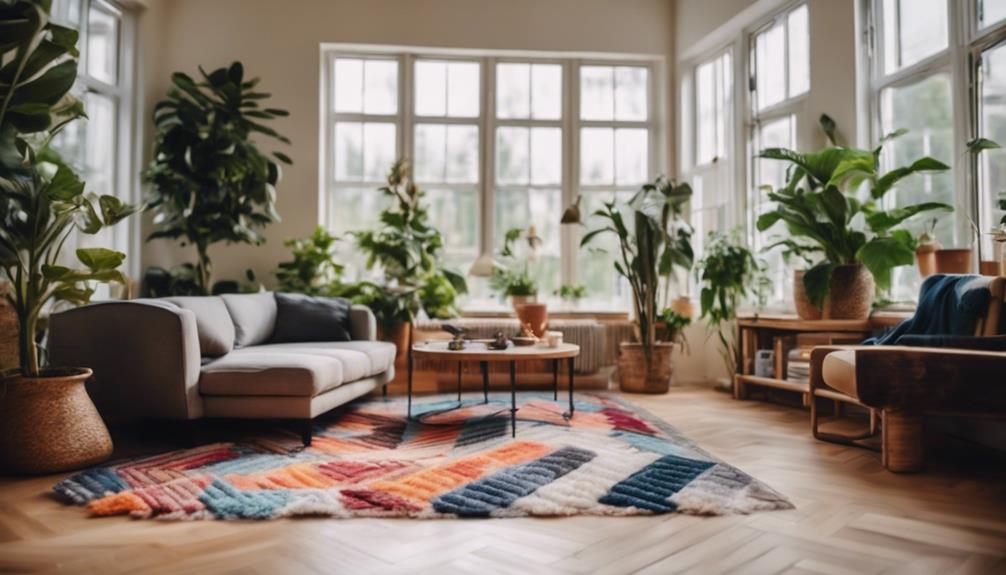
When it comes to flooring, you've got some exciting options to elevate your space.
Reclaimed wood floor planks add a rustic charm, while a textured concrete overlay finish offers a sleek, modern touch.
If you're looking for something fun, geometric patterned vinyl flooring can really make a statement in any room.
Reclaimed Wood Floor Planks
Reclaimed wood floor planks offer a sustainable flooring solution that not only reduces waste but also brings unique character and charm to your space. Sourced from salvaged wood materials, these planks provide an eco-friendly option that fits perfectly into any living space. You'll appreciate the durability and aesthetic appeal of reclaimed wood, which often showcases distinct knots, grains, and rich color variations.
Whether you're aiming for a rustic vibe or a contemporary look, reclaimed wood comes in various finishes and styles, allowing you to customize your decor. However, keep in mind that installation can be more labor-intensive than traditional flooring options. You might need specialized techniques to guarantee a proper fit and finish.
Another great benefit is that reclaimed wood generally enhances indoor air quality, as it's typically free from the harmful chemicals and finishes found in new flooring products. By choosing reclaimed wood floor planks, you're not only making a stylish choice but also a responsible one for both your home and the environment.
Transform your living space with this timeless flooring option that tells a story while being kind to the planet.
Textured Concrete Overlay Finish
Have you considered how a textured concrete overlay finish can transform your flooring into a stylish and durable feature? This innovative flooring option is perfect for both residential and commercial spaces, offering a unique aesthetic that mimics the appearance of natural materials like wood, stone, or tile. You can achieve the look you want without breaking the bank on costly materials.
The application process involves a blend of cement, polymers, and additives, allowing for customization in colors and textures to match your design vision. With proper installation and maintenance, textured concrete overlays can last for many years, making them a cost-effective solution that requires minimal upkeep.
Additionally, this flooring trend is eco-friendly, as many overlays incorporate recycled materials, supporting sustainable building practices.
Whether you're renovating your home or designing a commercial space, a textured concrete overlay can enhance your interior while providing a robust and resilient surface.
Geometric Patterned Vinyl Flooring
Looking to elevate your space without overspending? Geometric patterned vinyl flooring could be the stylish and budget-friendly solution you've been searching for. This flooring trend allows you to achieve a modern aesthetic without the hefty price tag associated with traditional materials. With a variety of colors and designs available, you can easily find a geometric pattern that complements your decor style, whether it's minimalist or maximalist.
One of the greatest advantages of geometric vinyl is its durability. It's perfect for high-traffic areas, ensuring your space remains trendy while standing up to daily wear and tear. Plus, the ease of installation makes it a fantastic DIY project, allowing you to transform your space quickly.
Modern geometric vinyl even mimics the look of natural materials like wood or stone, providing a warm feel underfoot. This means you can enjoy the aesthetics of luxury flooring while benefiting from the comfort and resilience of vinyl.
What Are the Latest Aesthetic Trends in Room Decor?
Looking for trendy room decor ideas? Some of the latest aesthetic trends in room decor include earthy tones, natural materials, and sustainable furniture. Incorporating indoor plants, textured wall art, and cozy lighting can also elevate your space. Additionally, mixing vintage pieces with modern accents is a popular trend in room decor.
Conclusion
By embracing these trendy room decor ideas, you can transform your space into a stylish sanctuary that reflects your personality.
Stay ahead of the curve with essential fixtures, innovative lighting, and unique decorative elements that make a statement.
Don't forget about flooring; it plays an important role in setting the mood.
So, get creative, experiment with different aesthetics, and watch your room come to life.
Your perfect, on-trend oasis is just a few thoughtful choices away!
